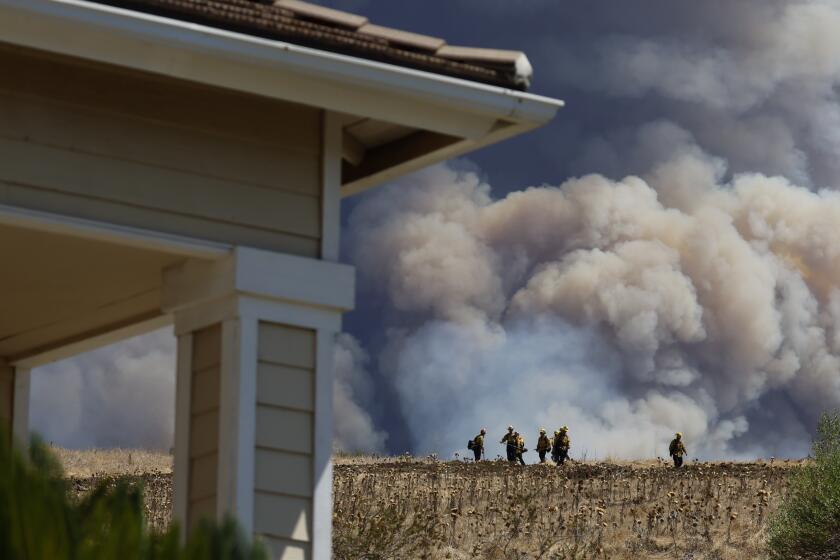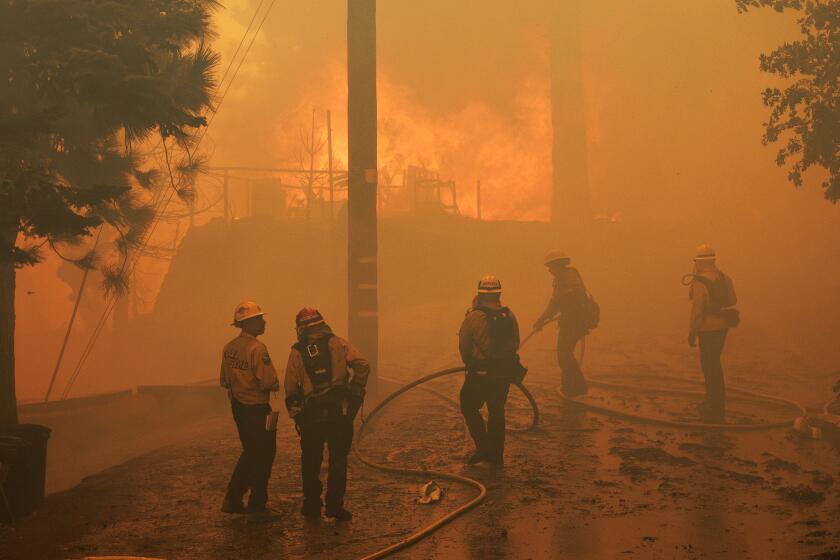Fire threatens Southern California ski resorts. Will they make it to winter?

- Share via
A number of Southern California’s most popular ski resorts are under threat from wildfires that are burning across the mountains that skiers glide down.
At the Mountain High Resort in Wrightwood, staff desperate to save the popular skiing spot turned on snowmakers to keep flames from the Bridge fire at bay.
The fire, which has charred 49,000 acres in the Angeles National Forest, exploded in size late Tuesday, burning homes and sending flames barreling through the trees toward Mountain High’s chairlifts. Despite the harrowing visuals captured on the resort’s cameras, all the main lifts and buildings survived with “little to no damage,” the resort wrote on social media Wednesday.
“Thank you to all the employees and fire fighters for their hard work. Our hearts go out to the Wrightwood families that may be suffering. We are with you!” the resort wrote in the post.
Ski resorts in the Big Bear region, meanwhile, were hoping to remain standing as the Line fire raged nearby, putting the mountain community on edge. The blaze, which started last week, has already charred more than 34,000 acres and was 14% contained Wednesday.
Crews were staging equipment on the hills at Snow Summit and Bear Mountain and trying to create defense perimeters around buildings, chairlifts and other improvements, resort spokesman Justin Kanton said as he sat in his office on the property, socked in by smoke.
At Snow Valley in Running Springs, which was closest to the fire’s front line, workers were using snowmaking guns to saturate the grounds in an attempt to keep embers from taking hold, Kanton said.
Three wildfires raged in Southern California on Tuesday night. The Bridge fire exploded to eight times its size as it raced toward the Mountain High Ski Resort and Wrightwood.
The resorts have suspended operations until further notice.
A nine-year resident of Sugarloaf, just south of Big Bear City, Kanton, 44, said he enjoys the bountiful nature and the varied weather. But he says he’s seen large fires encroaching on the peaceful community with increasing frequency.
“It’s one of the few places in Southern California where we actually get four true seasons,” he said. “Unfortunately it looks like, more and more, we’re starting to have a fifth season, which is fire season.”
Big Bear Mountain Resort, which operates the Snow Summit, Bear Mountain and Snow Valley resorts, reported its snowiest February on the mountain since at least 2000. The snowy winter, which helped plants grow, was followed by a hot and low-rainfall summer, which dried them out.
As Kanton sat in his office Wednesday, he watched as ash particles rained down from the sky. Usually, he can see across to the north shore of Big Bear Lake from his window, but on this day his view was obscured by haze. The west end of town was under an evacuation order, and the rest was told to prepare to evacuate if conditions worsened.
Kanton said he was prepared to leave town if needed and would probably head to Palm Springs to stay with friends. There’s currently just one way out — down winding Highway 18 into Lucerne Valley — so he hopes, if it comes to that, people will be patient and not panic.
“These things can escalate pretty quickly, especially given the weather conditions we’ve had,” he said.
An overview of evacuation orders, shelter options, mental health resources, donation info and more for the Airport, Bridge and Line fires in Southern California.
Big Bear Lake City Manager Erik Sund is hopeful the fires that have burned in the valley in recent years, including the Radford fire in 2022, will help mitigate the current blaze by cutting down on available fuel for the flames.
He’s still concerned about the damage to roads, though, given that all routes in and out of town have been shut down except for Highway 18. In addition to creating a potential choke point in an emergency, the closures hamper residents who commute to work and tourists who want to take advantage of Big Bear’s hiking trails and other attractions.
“After this fire gets behind us, the next thing we’ll be doing is assessing all of those things,” he said. “Because before you know it, it’ll be winter, and we’ll want to welcome visitors.”
Times staff writer Hannah Fry contributed to this report
More to Read
Sign up for Essential California
The most important California stories and recommendations in your inbox every morning.
You may occasionally receive promotional content from the Los Angeles Times.














